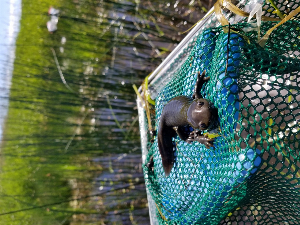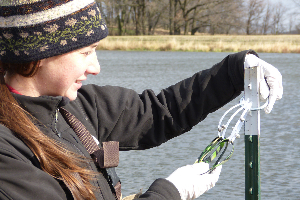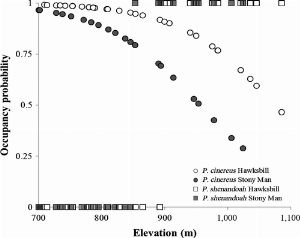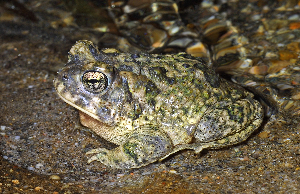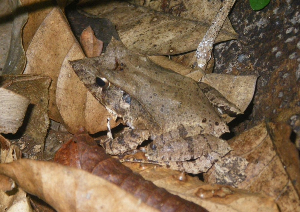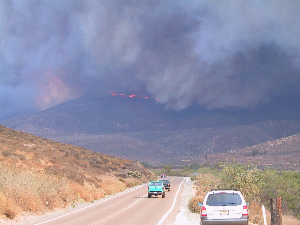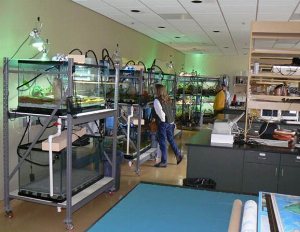Search ARMI Database
Search term(s)
Contribution Number
Search Results
879 record(s) found.
Papers & Reports Associations between environmental pollutants and larval amphibians in wetlands contaminated by energy-related brines are potentially mediated by feeding traits
Authors: Kelly L Smalling; Chauncey W Anderson; R K Honeycutt; I M Cozzarelli,; Todd Preston; Blake R Hossack
Date: 2019-02-22 | Outlet: Environmental Pollution
Energy production in the Williston Basin, located in the Prairie Pothole Region of central North America, has increased rapidly over the last several decades. Advances in disposal practices of saline wastewaters (brines) co-produced during energy production have reduced ecological risks, but spills still occur often and legacy practices of releasing brines into the environment caused persistent salinization in many areas. Aside from sodium and chloride, these brines contain elevated concentrations of heavy metals, ammonium, volatile organic compounds, hydrocarbons and radionuclides. Amphibians are especially sensitive to chloride but interactions among other environmental pollutants are possible wetlands contaminated by brines. We collected bed sediment and larval amphibians (Ambystoma mavortium, Lithobates pipiens and Pseudacris maculata) from wetlands in Montana and North Dakota representing a range of brine contamination history and severity to determine if contamination was associated with metal concentrations in sediments and if metal accumulation in tissues varied by species and feeding traits. Brine contamination was positively associated with the concentrations of sodium and strontium in sediments and negatively correlated with mercury. However, concentrations of several metals were correlated with differences in feeding traits (grazers vs. predators), which suggests frequent contact with the sediments could lead to greater ingestion of metal-laden materials. Although many of these metals may not be directly linked with energy development, the potential additive or synergistic effects of exposure along with elevated chloride from brines could have important consequences for aquatic organisms. To effectively manage amphibian populations in wetlands contaminated by saline wastewaters we need a more robust understanding of how life history traits, species-specific susceptibilities and the physical-chemical properties of metals co-occurring in wetland sediments interact with other stressors like chloride and wetland drying.
Papers & Reports Exploring the amphibian exposome in an agricultural landscape using telemetry and passive sampling
Authors: J E Swanson; Erin Muths; Clay L Pierce; S Dinsmore; M Vandever; Michelle L Hladik; Kelly L Smalling
Date: 2018-07-03 | Outlet: Scientific Reports (2018) 8:10045
This is the first field study of its kind to combine radio telemetry, passive samplers, and pesticide accumulation in tissues to characterize the amphibian exposome as it relates to pesticides. Understanding how habitat drives exposure in individuals (i.e., their exposome), and how that relates to individual health is critical to managing species in an agricultural landscape where pesticide exposure is likely. We followed 72 northern leopard frogs (Lithobates pipiens) in two agricultural wetlands for insight into where and when individuals are at high risk of pesticide exposure. Novel passive sampling devices (PSDs) were deployed at sites where telemetered frogs were located, then moved to subsequent locations as frogs were radio-tracked. Pesticide concentration in PSDs varied by habitat and was greatest in agricultural fields where frogs were rarely found. Pesticide concentrations in frogs were greatest in spring when frogs were occupying wetlands compared to late summer when frogs occupied terrestrial habitats. Our results indicate that habitat and time of year influence exposure and accumulation of pesticides in amphibians. Our study illustrates the feasibility of quantifying the amphibian exposome to interpret the role of habitat use in pesticide accumulation in frogs to better manage amphibians in agricultural landscapes.
Papers & Reports Beyond the swab: ecosystem sampling to understand the persistence of an amphibian pathogen
Authors: Brittany A Mosher; Kathryn P Huyvaert; Larissa L Bailey
Date: 2018 | Outlet: Oecologia,
Understanding the ecosystem-level persistence of pathogens is essential for predicting
and measuring host-pathogen dynamics. However, this process is often masked, in
part due to a reliance on host-based pathogen detection methods. The amphibian
pathogens Batrachochytrium dendrobatidis (Bd) and B. salamandrivorans (Bsal) are
pathogens of global conservation concern. Despite having free-living life stages, little is
known about the distribution and persistence of these pathogens outside of their
amphibian hosts. We combine historic amphibian monitoring data with contemporary
host- and environment-based pathogen detection data to obtain estimates of Bd
occurrence independent of amphibian host distributions. We also evaluate differences
in filter- and swab-based detection probability and assess inferential differences arising
from using different decision criteria used to classify samples as positive or negative.
Water filtration-based detection probabilities were lower than those from swabs but
were >10%, and swab-based detection probabilities varied seasonally, declining in the
early fall. The decision criterion used to classify samples as positive or negative was
important; using a more liberal criterion yielded higher estimates of Bd occurrence than
when a conservative criterion was used. Different covariates were important when
using the liberal or conservative criterion in modeling Bd detection. We found evidence
of long-term Bd persistence for several years after an amphibian host species of
conservation concern, the boreal toad (Anaxyrus boreas boreas), was last detected.
Our work provides evidence of long-term Bd persistence in the ecosystem and
underscores the importance of environmental samples for understanding and
mitigating disease-related threats to amphibian biodiversity.
and measuring host-pathogen dynamics. However, this process is often masked, in
part due to a reliance on host-based pathogen detection methods. The amphibian
pathogens Batrachochytrium dendrobatidis (Bd) and B. salamandrivorans (Bsal) are
pathogens of global conservation concern. Despite having free-living life stages, little is
known about the distribution and persistence of these pathogens outside of their
amphibian hosts. We combine historic amphibian monitoring data with contemporary
host- and environment-based pathogen detection data to obtain estimates of Bd
occurrence independent of amphibian host distributions. We also evaluate differences
in filter- and swab-based detection probability and assess inferential differences arising
from using different decision criteria used to classify samples as positive or negative.
Water filtration-based detection probabilities were lower than those from swabs but
were >10%, and swab-based detection probabilities varied seasonally, declining in the
early fall. The decision criterion used to classify samples as positive or negative was
important; using a more liberal criterion yielded higher estimates of Bd occurrence than
when a conservative criterion was used. Different covariates were important when
using the liberal or conservative criterion in modeling Bd detection. We found evidence
of long-term Bd persistence for several years after an amphibian host species of
conservation concern, the boreal toad (Anaxyrus boreas boreas), was last detected.
Our work provides evidence of long-term Bd persistence in the ecosystem and
underscores the importance of environmental samples for understanding and
mitigating disease-related threats to amphibian biodiversity.
Papers & Reports Prioritizing conserved areas threatened by wildfire for monitoring and management
Authors: J Tracey; Carlton J Rochester; Stacie A Hathaway; Kristine L Preston; A Syphard; A G Vandergast; J Diffendorfer; J Franklin; J MacKenzie; T Oberbauer; S Tremor; C Winchell; Robert N Fisher
Date: 2018-09-07 | Outlet: PLoS ONE
In many parts of the world, the combined effects of habitat fragmentation and altered disturbance regimes pose a significant threat to biodiversity. This is particularly true in Mediterranean-type ecosystems (MTEs), which tend to be fire-prone, species rich, and heavily impacted by human land use. Given the spatial complexity of overlapping threats and species? vulnerability along with limited conservation budgets, methods are needed for prioritizing areas for monitoring and management in these regions. We developed a multi-criteria Pareto ranking methodology for prioritizing spatial units for conservation and applied it to fire threat, habitat fragmentation threat, species richness, and genetic biodiversity criteria in San Diego County, California, USA. We summarized the criteria and Pareto ranking results (from west to east) within the maritime, coastal, transitional, inland climate zones within San Diego County. Fire threat increased from the maritime zone eastward to the transitional zone, then decreased in the mountainous inland climate zone. Number of fires and fire return interval departure were strongly negatively correlated. Fragmentation threats, particularly road density and development density, were highest in the maritime climate zone and declined as we moved eastward and were positively correlated. Species richness criteria showed distributions among climate zones similar to that of the fire threat variables. When using species richness and fire threat criteria, most lower-ranked (higher conservation priority) units occurred in the coastal and transitional zones. When considering genetic biodiversity, lower-ranked units occurred more often in the mountainous inland zone. With Pareto ranking, there is no need to select criteria weights as part of the decision-making process. However, negative correlations and larger numbers of criteria can result in more units assigned to the same rank. Pareto ranking is broadly applicable and can be used as a standalone decision analysis method or in conjunction with other methods.
Papers & Reports Evidence that climate sets the lower elevation range limit in a high-elevation endemic salamander
Authors: Evan HC Grant; Adrianne B Brand; S FJ DeWekker; T R Lee; John EB Wofford
Date: 2018-07-06 | Outlet: Ecology and Evolution
A frequent assumption in ecology is that biotic interactions are more important than abiotic factors in determining lower elevational range limits (i.e., the ?warm edge? of a species distribution). However, for species with narrow environmental tolerances, theory suggests the presence of a strong environmental gradient can lead to persistence, even in the presence of competition. The relative importance of biotic and abiotic factors are rarely considered together, though understanding when one exerts a dominant influence on controlling range limits may be crucial to predicting extinction risk under future climate conditions. Multiple transects spanning the elevational range limit of Plethodon shenandoah were sampled, and site and climate covariates were recorded. A two-species conditional occupancy model, accommodating heterogeneity in detection probability, was used to relate variation in occupancy with environmental and habitat conditions. Regional climate data were combined with datalogger observations to estimate the cloud base heights and to project future climate change impacts on cloud elevations across the survey area. By simultaneously accounting for species? interactions and habitat variables, we find that elevation, not competition, is strongly correlated with the lower elevation range boundary for a high-elevation endemic salamander, which had been presumed to be restricted mainly as a result of competitive interactions with a congener. Because the lower elevational range limit is sensitive to climate variables, projected climate change across its high-elevation habitats will directly affect the species? distribution. Testing of assumptions of factors that set species range limits should use models which accommodate detection biases.
Papers & Reports Multi-scale effects of land cover and urbanization on the habitat suitability of an endangered toad.
Authors: M Treglia; A Landon; Robert N Fisher; G Kyle; L Fitzgerald
Date: 2018-11-10 | Outlet: Biological Conservation 228:310-318
Habitat degradation, entwined with land cover change, is a major driver of biodiversity loss. Effects of land cover change on species can be direct (when habitat is converted to alternative land cover types) or indirect (when land outside of the species habitat is altered). Hydrologic and ecological connections between terrestrial and aquatic systems are well understood, exemplifying how spatially disparate land cover conditions may influence aquatic habitats, but are rarely examined. We sought to quantify relative effects of land cover at two different but interacting scales on habitat suitability for the endangered arroyo toad (Anaxyrus californicus). Based on an existing distribution model for the arroyo toad and available land cover data, we estimated effects of land cover along streams and within entire watersheds on habitat suitability using structural equation modeling. Relationships between land cover and habitat suitability differed between scales, and broader, watershed-scale conditions influenced land cover along the embedded stream networks. We found anthropogenic development and forest cover at the watershed-scale negatively impacted habitat suitability, but development along stream networks was positively associated with suitability. The positive association between development along streams and habitat suitability may be attributable to increased spatial heterogeneity along urbanized streams, or related factors including policies designed to conserve riparian habitats amidst development. These findings show arroyo toad habitat is influenced by land cover across multiple scales, and can inform conservation of the species. Furthermore, our methodology can help elucidate similar dynamics with other taxa, particularly those reliant on
both terrestrial and aquatic environments.
both terrestrial and aquatic environments.
Papers & Reports Amphibians of the Pacific: natural history and conservation.
Authors: G Zug; Robert N Fisher
Date: 2018 | Outlet: in: Status of Conservation and Decline of Amphibians: Australia, New Zealand and Pacific Islands. Clayton, Vic. CSIRO Publishing.
Endemic anurans occur, with only three exceptions, on the periphery of the Pacific Basin, and only one island group, the Solomon Islands, is a "stepping stone" archipelago that, although lacking past land connections, was nearly connected to a continent or continental islands. This fauna is dominated by species within the family Ceratobatrachidae, all of which have direct development in their eggs, and lack a free living larval stage, an important life-history characteristic when living on variable island habitats where water might be greatly limited. This chapter examines the diversity of native frogs and the current environmental conditions that continue to support the persistence of frog populations and those conditions that push frog populations to local extirpation and eventually to extinction. The non-native (alien) frogs, cane toad, and the diverse anuran fauna of Guam, allow an examination of the physical and biotic environment that permits successful establishment of frogs, and the physiological and behavioural characteristics of successful, invasive species of frogs.
Papers & Reports Setting priorities for private land conservation in fire-prone landscapes: Are fire risk reduction and biodiversity conservation competing or compatible objectives?
Authors: A D Syphard; Van Butsic; Avi Bar-Massada; J E Keeley; J Tracey; Robert N Fisher
Date: 2016 | Outlet: Ecology and Society 21(3):2.
Although wildfire plays an important role in maintaining biodiversity in many ecosystems, fire management to protect human assets is often carried out by different agencies than those tasked for conserving biodiversity. In fact, fire risk reduction and biodiversity conservation are often viewed as competing objectives. Here we explored the role of management through private land conservation and asked whether we could identify private land acquisition strategies that fulfill the mutual objectives of biodiversity conservation and fire risk reduction, or whether the maximization of one objective comes at a detriment to the other. Using a fixed budget and number of homes slated for development, we simulated 20 years of housing growth under alternative conservation selection
strategies, and then projected the mean risk of fires destroying structures and the area and configuration of important habitat types in San Diego County, California, USA. We found clear differences in both fire risk projections and biodiversity impacts based on the way conservation lands are prioritized for selection, but these differences were split between two distinct groupings. If no conservation lands were purchased, or if purchases were prioritized based on cost or likelihood of development, both the projected fire risk and biodiversity impacts were much higher than if conservation lands were purchased in areas with high fire hazard or high species richness. Thus, conserving land focused on either of the two objectives resulted in nearly equivalent mutual benefits for both. These benefits not only resulted from preventing development in sensitive areas, but they were also due to the different housing patterns and arrangements that occurred as development was displaced from those areas. Although biodiversity conflicts may still arise using other fire management strategies, this study shows that mutual objectives can be attained through land-use planning in this region. These results likely generalize to any place where high species richness overlaps with hazardous wildland vegetation.
strategies, and then projected the mean risk of fires destroying structures and the area and configuration of important habitat types in San Diego County, California, USA. We found clear differences in both fire risk projections and biodiversity impacts based on the way conservation lands are prioritized for selection, but these differences were split between two distinct groupings. If no conservation lands were purchased, or if purchases were prioritized based on cost or likelihood of development, both the projected fire risk and biodiversity impacts were much higher than if conservation lands were purchased in areas with high fire hazard or high species richness. Thus, conserving land focused on either of the two objectives resulted in nearly equivalent mutual benefits for both. These benefits not only resulted from preventing development in sensitive areas, but they were also due to the different housing patterns and arrangements that occurred as development was displaced from those areas. Although biodiversity conflicts may still arise using other fire management strategies, this study shows that mutual objectives can be attained through land-use planning in this region. These results likely generalize to any place where high species richness overlaps with hazardous wildland vegetation.
Papers & Reports Mapping habitat for multiple species in the Desert Southwest.
Authors: R D Inman; K E Nussear; T C Esque; A G Vandergast; Stacie A Hathaway; D A Wood; Kelly R Barr; Robert N Fisher
Date: 2014 | Outlet: U.S. Geological Survey Open-File Report 2014-1134, pp. 92
Many utility scale renewable energy projects are currently proposed across the Mojave Ecoregion. Agencies that manage biological resources throughout this region need to understand the potential impacts of these renewable energy projects and their associated infrastructure (for example, transmission corridors, substations, access roads, etc.) on species movement, genetic exchange among
populations, and species’ abilities to adapt to changing environmental conditions. Understanding these
factors will help managers select appropriate project sites and possibly mitigate for anticipated effects of management activities. We used species distribution models to map habitat for 15 species across the Mojave Ecoregion to aid regional land-use management planning. Models were developed using a common 1 × 1 kilometer resolution with maximum entropy and generalized additive models. Occurrence data were compiled from multiple sources, including VertNet (http://vertnet.org/index.php), HerpNET (http://www.herpnet.org), and MaNIS (http://manisnet.org), as well as from internal U.S. Geological Survey databases and other biologists. Background data included 20 environmental covariates representing terrain, vegetation, and climate covariates. This report summarizes these environmental covariates and species distribution models used to predict habitat for the 15 species across the Mojave Ecoregion.
populations, and species’ abilities to adapt to changing environmental conditions. Understanding these
factors will help managers select appropriate project sites and possibly mitigate for anticipated effects of management activities. We used species distribution models to map habitat for 15 species across the Mojave Ecoregion to aid regional land-use management planning. Models were developed using a common 1 × 1 kilometer resolution with maximum entropy and generalized additive models. Occurrence data were compiled from multiple sources, including VertNet (http://vertnet.org/index.php), HerpNET (http://www.herpnet.org), and MaNIS (http://manisnet.org), as well as from internal U.S. Geological Survey databases and other biologists. Background data included 20 environmental covariates representing terrain, vegetation, and climate covariates. This report summarizes these environmental covariates and species distribution models used to predict habitat for the 15 species across the Mojave Ecoregion.
Papers & Reports Chapter D. Summary and conclusions.
Authors: R Schroeder; Elizabeth A Gallegos; G Smith; P Martin; Robert N Fisher
Date: 2015 | Outlet: U.S. Geological Survey Scientific Investigations Report pp 97-106
Hydrological and biological investigations were done during 2005 and 2006 in cooperation with the U.S. National Park Service at Darwin Falls in Death Valley National Park, Piute Spring in Mojave National Preserve, and Fortynine Palms Oasis in Joshua Tree National Park where discharge from springs or groundwater seeps sustains rare perennial streams in the otherwise arid environment of the Mojave Desert in which surface water is scarce and usually ephemeral. The study collected data on water quantity (discharge), temperature, water quality, and endemic anuran (frog and toad) populations and their health. In addition, a single survey of endemic anuran populations and their health was completed at Rattlesnake Canyon in the Joshua Tree National Park. Results from this study were compared to historical data, and can provide a baseline for future hydrological and biological investigations to evaluate health and sustainability of the resource as well as its response to changing climate and increases in human use.
Papers & Reports Chapter C. Anuran abundance and health at selected springs in the Mojave network parks.
Authors: Elizabeth A Gallegos; Robert N Fisher
Date: 2015 | Outlet: U.S. Geological Survey Scientific Investigations Report pp. 77-95
Data collected from the biological surveys completed for this study were evaluated to document the reproduction, estimate the population, and assess the overall health of each of the endemic anuran species present at the Darwin Falls, Piute Spring, and Fortynine Palms Oasis study areas. Where available, historical biological data also were evaluated.
Papers & Reports Conservation and recovery of the mountain yellow-legged frog in southern California, USA.
Authors: Adam R Backlin; Elizabeth A Gallegos; Robert N Fisher
Date: 2012 | Outlet: Global Re-introduction perspectives:2011, more case studies from around the globe, Soorae, P.S., ed. Re-introduction specialist Group and Abu Dhabi, UAE: Environment Agency-Abu Dhabi. Gland, Switzerland pp. 77-80
Papers & Reports Chapter 6. Voucher specimens: Appendix C. Field parasitology techniques for reptile surveys.
Authors: S L Gardner; Robert N Fisher; Sean J Berry
Date: 2012 | Outlet: Reptile Biodiversity: Standard Methods of Inventory and Monitoring
Studies of the systematics and ecological characteristics of hosts and their parasites require proper identification of both groups. When the parasites associated with a host are not collected
and preserved properly, species- level diagnostic characters (i.e., morphological characters) are usually destroyed. In addition, improper preservation of parasites severely limits,
or more likely prevents, studies based on DNA from those specimens.
and preserved properly, species- level diagnostic characters (i.e., morphological characters) are usually destroyed. In addition, improper preservation of parasites severely limits,
or more likely prevents, studies based on DNA from those specimens.
Papers & Reports Chapter 4. Planning and associated data: Data quality assurance and quality control.
Authors: A Atkinson; Carlton J Rochester; Robert N Fisher
Date: 2012 | Outlet: Reptile Biodiversity: Standard Methods of Inventory and Monitoring
Papers & Reports Chapter 4. Planning and associated data: Databases, metadata, and integrated data management.
Authors: Christopher W Brown; Robert N Fisher
Date: 2012 | Outlet: in: Reptile Biodiversity: Standard Methods of Inventory and Monitoring
One end goal of a study is to analyze and synthesize the data collected in an effort to understand their meaning. Most data from field studies are analyzed in an electronic format, using modern software packages for models and statistics. Consequently, how the data are stored is important and should be considered simultaneously with protocol development. Data definitions and data storage should reflect how the data are collected in the field and how they ultimately will be analyzed.
Papers & Reports Chapter 4. Planning and associated data: Handheld computers for digital data collection.
Authors: Carlton J Rochester; Robert N Fisher
Date: 2012 | Outlet: in: Reptile Biodiversity: Standard Methods of Inventory and Monitoring
Here, we describe an alternative to traditional penand-paper data recording. With recent advancements in handheld computers and their software applications, the development and use of electronic forms for recording data (using Personal Digital Assistants, or PDAs), a topic that has only been mentioned briefly in previous literature (e.g., Donnelly and Guyer 1994), has become a reality. Multiple operating platforms for PDAs, including handheld PCs, Pocket PCs, and the Palm OS (see Appendix II), are now on the market. Each one offers mobile, electronic data collection and its associated benefits to investigators in the fi eld. Below, we outline some of the advancements that have been made over the past 10 years in the use of PDAs for recording data, and we compare the benefits of recording field data electronically with those of data entry on paper sheets.
Papers & Reports Thamnophis hammondii (two-striped garter snake): Prey.
Authors: Edward L Ervin; S J Mullin; Robert N Fisher
Date: 2003 | Outlet: Herpetological Review 34(1):74-75
Papers & Reports Introduced parasites of freshwater fish in southern California, U.S.A.
Authors: B I Kuperman; V E Matey; M L Warburton; Robert N Fisher
Date: 2002 | Outlet: pp. 407-411 in: Proceedings of the 10th International Congress of Parasitology - ICOPA X. Monduzzi Editore S.p.A. - MEDIMOND Inc., Bologna, Italy. 660 pp.
Papers & Reports Thamnophis hammondii (two-striped garter snake): Prey.
Authors: Edward L Ervin; Robert N Fisher
Date: 2001 | Outlet: Herpetological Review 32(4):265-266
Papers & Reports Urban and suburban areas.
Authors: Robert N Fisher
Date: 2016 | Outlet: Habitat Management Guidelines for Amphibians and Reptiles of the Southwestern United States 154-157

